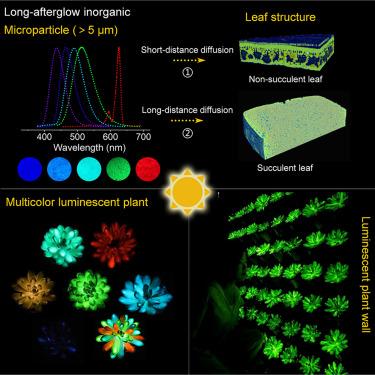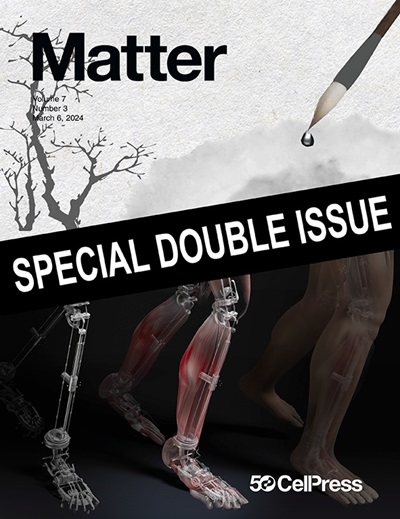在材料工程的活植物中,由阳光驱动的多色和均匀发光
IF 17.5
1区 材料科学
Q1 MATERIALS SCIENCE, MULTIDISCIPLINARY
引用次数: 0
摘要
植物照明在包括建筑和城市规划在内的各个领域都具有巨大的潜力。然而,控制植物发光的颜色和强度一直是一个挑战。传统的基因工程方法受到生物发光基因多样性有限的限制。由于纳米颗粒表面缺陷的增加,材料工程植物往往具有较差的光学性能,并且粒子的传输进一步受到植物空间分辨物理的限制。为了应对这些挑战,我们创新地将微米级的余辉颗粒(>5 μm)引入到月影草中。这种肉质植物紧凑的微观结构和丰富的细胞间空间有助于大颗粒的有效运输,从而产生均匀、增强的多色发光。这种方法超越了传统的颗粒大小和发光性能之间的权衡,生产出具有阳光充电的明亮发光植物,并首次实现了多色发光植物的成功开发。该工艺简单且具有成本效益,可在10分钟内实现发光,为植物照明的实际应用铺平了道路。本文章由计算机程序翻译,如有差异,请以英文原文为准。

Sunlight-powered multicolor and uniform luminescence in material-engineered living plants
Plant-based lighting holds significant potential across various fields, including architecture and urban planning. However, manipulating luminescence color and intensity in plants has been challenging. Traditional genetic engineering approaches are constrained by the limited diversity of bioluminescent genes. Material-engineered plants often have poor optical performance due to increased surface defects in nanoparticles, and particle transport is further limited by the spatially resolved physics of plants. To address these challenges, we innovatively introduced micron-sized afterglow particles (>5 μm) into Echeveria ‘Mebina’. This succulent’s compact microstructure and abundant intercellular spaces facilitate efficient transport of larger particles, resulting in uniform, enhanced, multicolor luminescence. This approach surpasses the traditional trade-off between particle size and luminescence performance, producing brightly luminescent plants with sunlight recharging and, for the first time, enabling successful development of multicolor luminescent plants. The process is straightforward and cost-effective and achieves luminescence within 10 min, paving the way for practical applications in plant-based lighting.
求助全文
通过发布文献求助,成功后即可免费获取论文全文。
去求助
来源期刊

Matter
MATERIALS SCIENCE, MULTIDISCIPLINARY-
CiteScore
26.30
自引率
2.60%
发文量
367
期刊介绍:
Matter, a monthly journal affiliated with Cell, spans the broad field of materials science from nano to macro levels,covering fundamentals to applications. Embracing groundbreaking technologies,it includes full-length research articles,reviews, perspectives,previews, opinions, personnel stories, and general editorial content.
Matter aims to be the primary resource for researchers in academia and industry, inspiring the next generation of materials scientists.
 求助内容:
求助内容: 应助结果提醒方式:
应助结果提醒方式:


